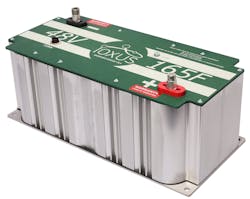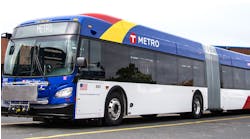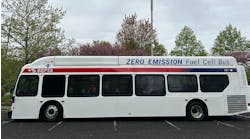For those of us who have ever had to roll up our windows to avoid black smoke approaching from the bus ahead, or have been stuck waiting in the freezing cold for a bus that is unable to start — your dreams of this changing anytime soon in the United States are slim. This is because the majority of buses are still powered by outdated, battery-based energy systems — even for hybrid buses.
The manufacturing of hybrid buses for reduced emissions and eco-friendly travel is an industry that reaches back almost 20 years. What may come as a surprise is that its adoption of ultracapacitor technology is nothing new, either. For nearly 9 years, hybrid buses have been taking advantage of an ultracapacitor’s ability to charge and discharge more than 1 million times more compared to a battery. These energy storage devices improve overall performance by alleviating the battery from many of its responsibilities. The battery provides the consistent low energy needed for long stretches, while the ultracapacitor handles all of the high current work due to its low resistance. A hybridized storage system of ultracapacitors and batteries allows for the strengths and weaknesses of each to balance out.
While the adoption of ultracapacitors for hybrid buses is on the rise, the U.S. market is slow to implement the technology, primarily because there is a lack of understanding and service support. The challenges for ultracapacitor implementation here aren’t technical, but rather educational and the willingness to be prepared, due to the lack of research and development money from these companies.
The Benefits
Since ultracapacitors charge and discharge very quickly, they’re ideal for recovering energy that would otherwise be lost during the braking process. The energy is absorbed and stored within the ultracapacitor’s cells and used to assist in accelerating the bus, which allows the diesel engine to reduce the amount of power it generates, so that it’s only used for maintaining speed. Combine this with the ultracapacitor’s smaller size and lightweight material and you’ve now got a more powerful, efficient hybrid system with better fuel mileage, reduced emissions, far less wear on the brakes, and minimal torque loads that will extend the lifespan of the engine. Furthermore, without the need for large, cumbersome batteries, designers can factor in additional passengers onto the bus or include other desired features.
Often overlooked is recyclability. Battery-based systems, lead-acid or lithium-ion, either have no sustainable process of disposal, or can be very expensive and harmful to the environment. Ultracapacitors have no detrimental effects on the environment and are built to provide cost-effective, green energy solutions that are 95 percent-plus recyclable.
Regardless of what ESS system is used, OEMs and customers want their buses to run efficiently and to operate as long as possible with little maintenance required. This is a challenge for batteries in any application, but especially for the demanding conditions of hybrid buses. Heat, cold, vibration — all of these factors can harm or destroy not just batteries, but ultracapacitors as well.
With numerous benefits resulting directly and indirectly from ultracapacitors, it is not surprising that its use continues to grow internationally. This is especially the case in areas of China where 10,000 hybrid buses have been built in the past year to support the country’s initiative to put 5 million alternative energy-powered vehicles on the road by 2020. In fact, ultracapacitors are being used on diesel buses throughout China to reduce emissions of these buses by up to 72 percent.
So Why is the U.S. Stalling on Ultracapacitors?
A black cloud is hanging over the hybrid industry due to government subsidies that support high-priced batteries costing anywhere from $50,000-100,000 per hybrid system, which the subsidy pays for a large portion of. Because these systems are so inefficient, bus companies will never earn their investment back before the battery reaches its replacement stage. Companies more often than not choose to dehybridize its systems once it is determined how expensive battery replacement is without government subsidiaries. In China, an ultracapacitor-based hybrid system costs about $25,000 with the ultracapacitor accounting for about $10,000 of the total costs and is paid back within five years, or even less time for smaller systems.
Also contributing to the slow growth in the U.S. is a non-existent process for servicing hybrid and electric buses that use ultracapacitors. The U.S. doesn’t have companies producing ultracapacitor-based systems that can also handle necessary repairs and maintenance. They simply aren’t equipped to do both, unlike battery companies that are making billions selling and servicing them. Customers buying ultracapacitors instead depend on the system’s supplier or manufacturer for service, increasing costs and limiting options. Asian bus companies aren’t only big enough to do both, but they understand the technology — and that’s the third missing piece to the puzzle.
How Do We Fix This?
In the states, focus is placed on developing the mechanical skills needed for current battery systems, not properly trained technicians to service electric or hybrid systems. U.S. engineers only spend roughly 30 to 60 minutes learning about capacitors in college, which creates misconceptions and a difficult environment for any alternative energy to grow.
In order for the U.S. hybrid bus market to find success, there needs to be a shift in the way manufacturers and engineers view current and new energy storage systems. By doing so, hopefully we can than communicate to the Department of Energy the success other countries are having with these systems and the impact its having on their economies. As a country with the second highest CO2 emissions, it is our responsibility to promote cost-effective, clean technologies that will evolve to support developing market needs. Time and time again ultracapacitors have proven to be the most reliable and offer the greatest return on investment of any ESS available today. U.S engineers and manufacturers cannot continue limiting the progression of hybrid buses and other applications by ignoring these facts. Doing so will see us fall further behind domestically and on a global energy scale.
Chad Hall is the co-founder and VP of marketing and product management for Ioxus.


